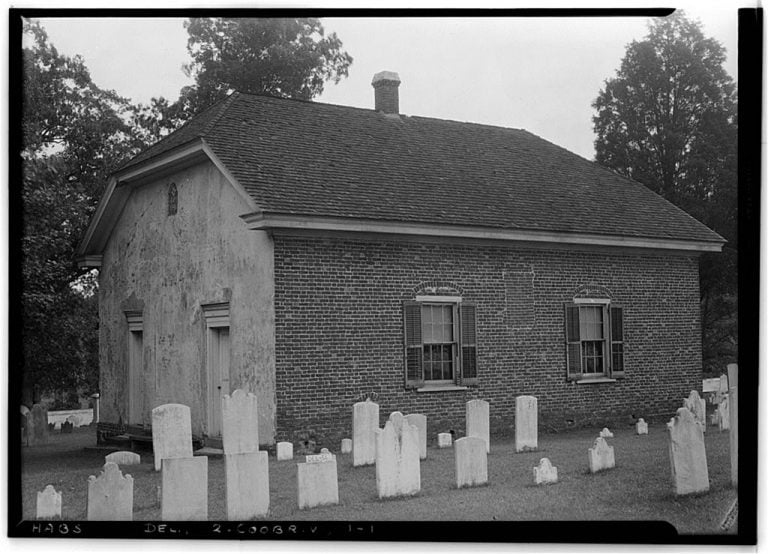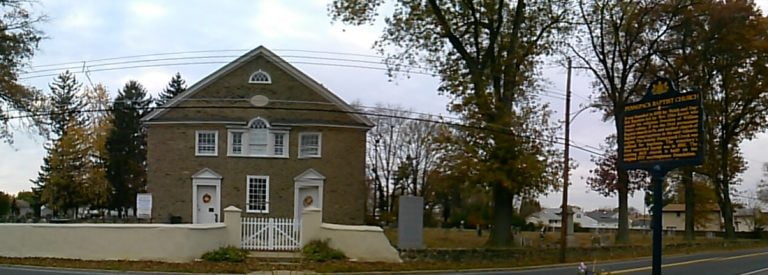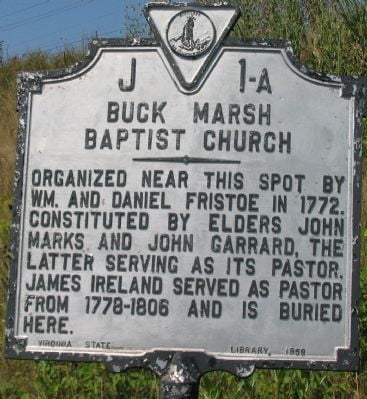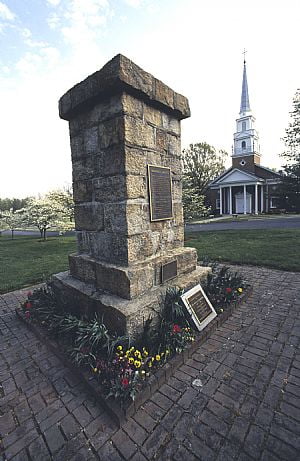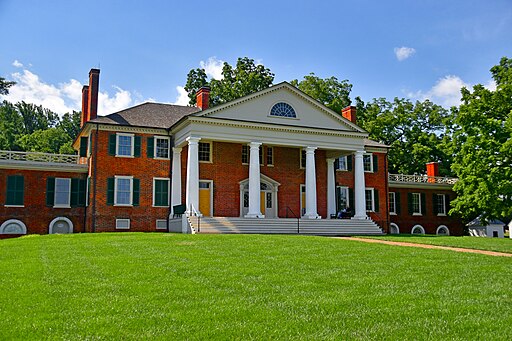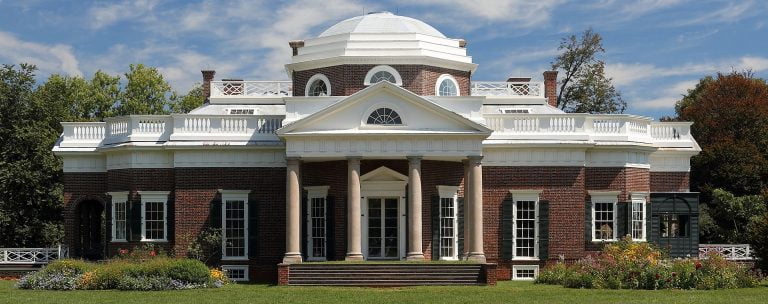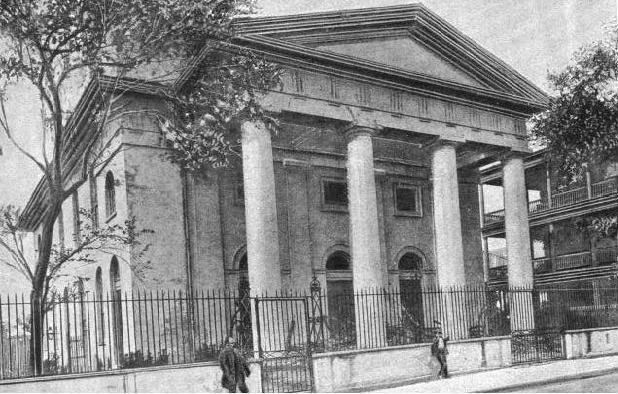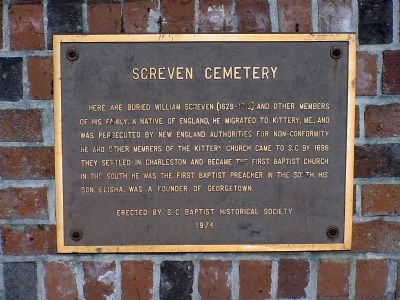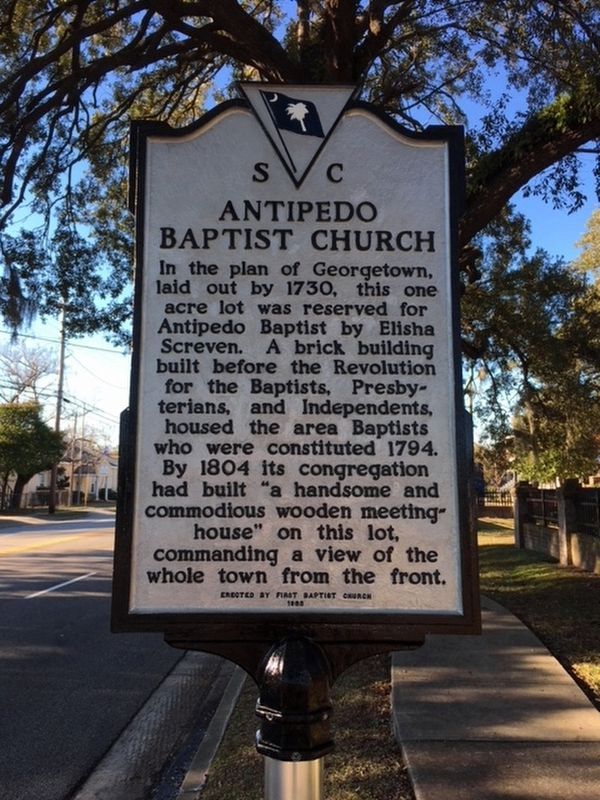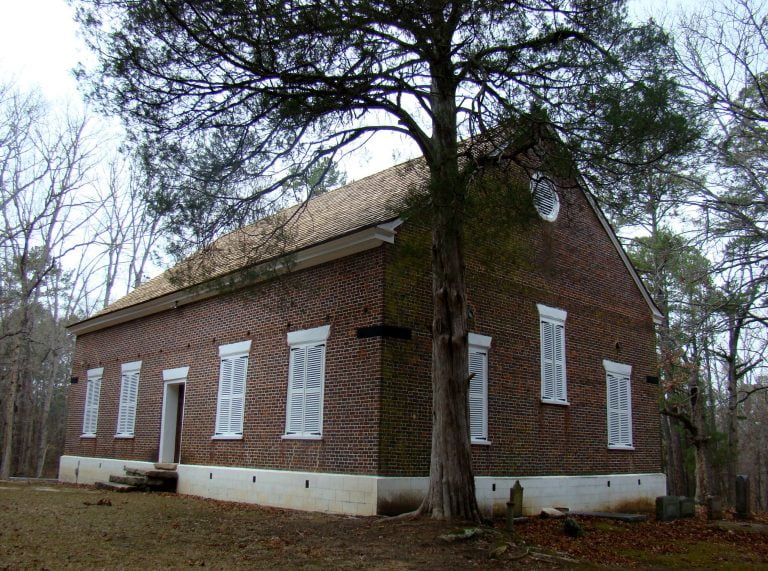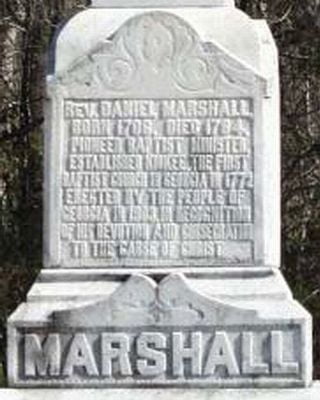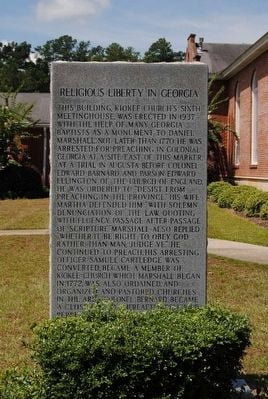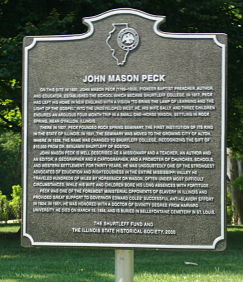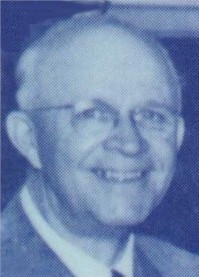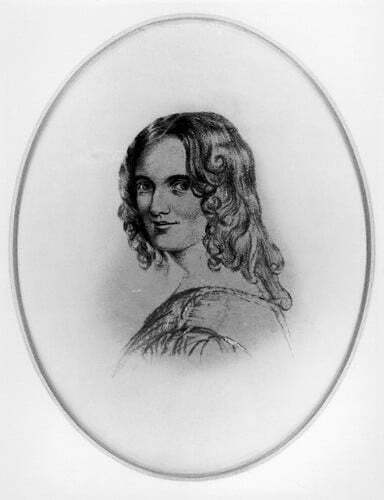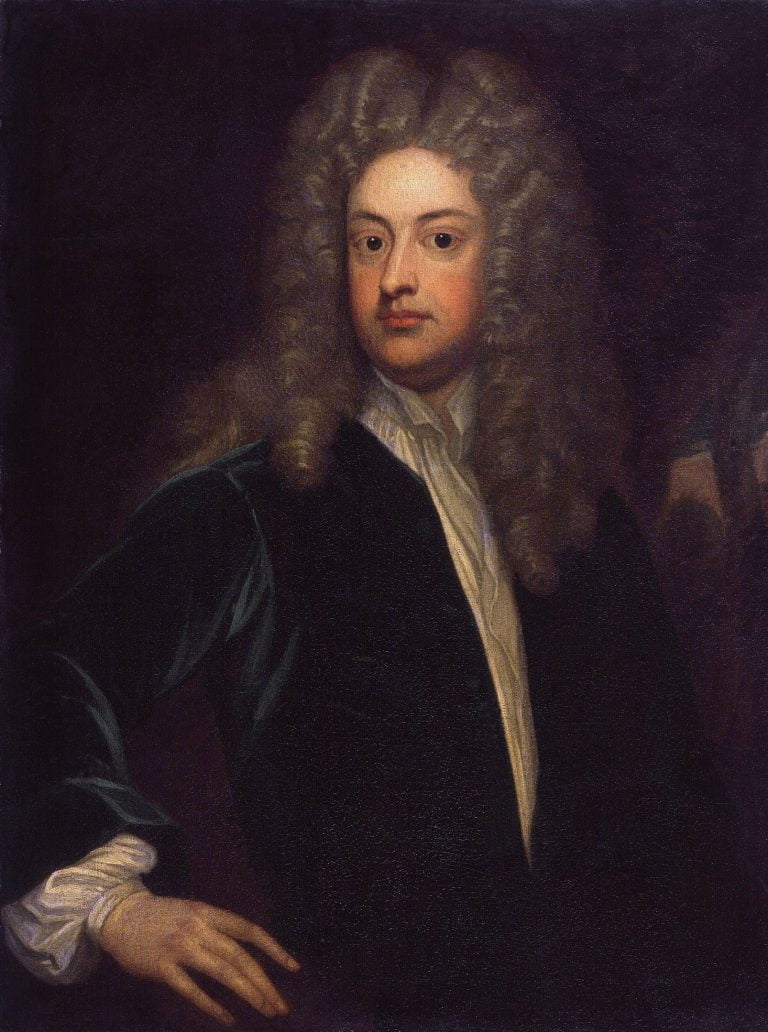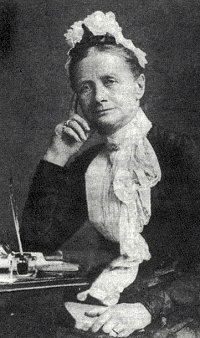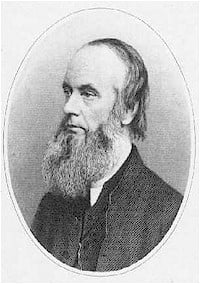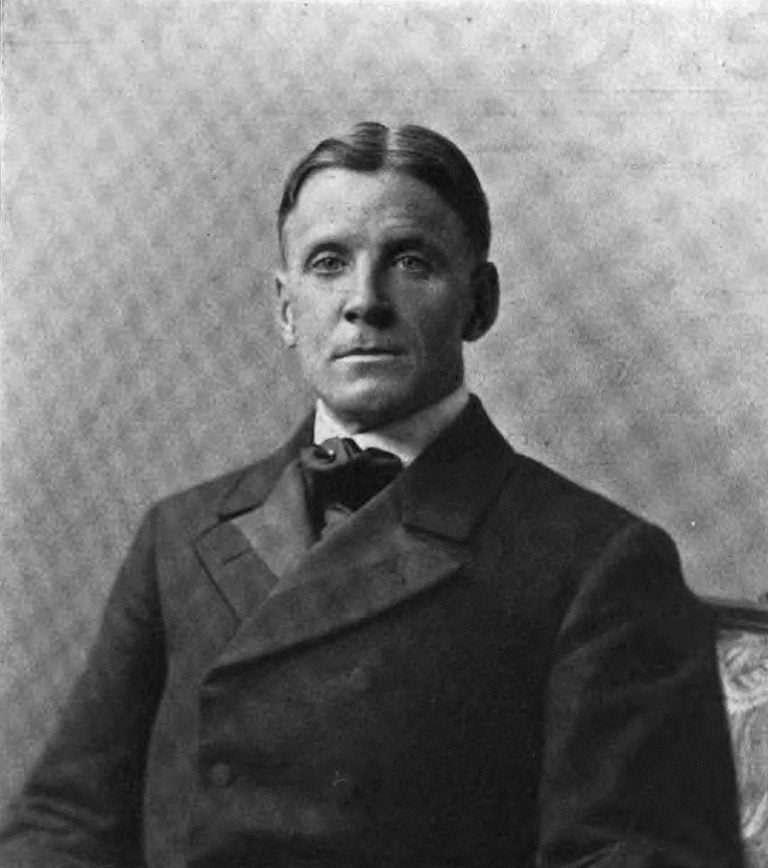Favorite
The Welsh Tract Baptist Church, on Welsh Tract Road, originated in 1701, when sixteen people formed the original congregation in Wales. In 1703, they settled on a thousand acre tract of land, granted by William Penn and since known as the Welsh Tract. As the first Baptist church in Delaware and situated a couple of miles south of Newark, they Read more...
Favorite
Pennepack Baptist Church, founded by Elias Keach, in 1688, is the oldest surviving Baptist church in the Middle Colonies. In 1805, at the peak of the Second Great Awakening, during the ministry of Samuel Jones, the congregation erected its present (third) building, constructed from fieldstone collected from the surrounding meadows. Straight-backed box pews occupy the main floor. An elegant, high Read more...
Favorite
Berryville (formerly Buckmarsh) Baptist Church is at 114 Academy Street. John Gerrard (Garrard, ca. 1720-87), in 1772, constituted the Buckmarsh church. James Ireland (ca. 1745-1806) served the Buckmarsh pastorate from 1786 until his death. Ireland’s remains lie in an unknown grave in the Buckmarsh cemetery. A historical plaque marks the site where Buckmarsh Baptist once stood. The plaque is only Read more...
Favorite
On Washington Avenue, stands the Thomas Jefferson Religious Freedom Monument, made from stones sent from churches across the country. It commemorates Jefferson’s Virginia Religious Freedom Statute, promising that “no man shall… suffer on account of his religious opinions or belief.” The Statute became the basis for the religion clause of the First Amendment. copyrighted and used by permission from David Beale, Baptist History Read more...
Favorite
Nearby is Montpelier, home of the two-term, fourth President, James Madison – Father of the Constitution and Architect of the Bill of Rights. It was here that Dolley Madison earned the epithet “America’s first, ‘First Lady’.” Montpelier is at 11350 Constitution Highway, Montpelier Station. copyrighted and used by permission from David Beale, Baptist History in England and America: Personalities, Positions, and Read more...
Favorite
A short drive southwest of Orange is Monticello, at 931 Thomas Jefferson Parkway, Charlottesville, the home of President Thomas Jefferson – principal author of the Declaration of Independence. His tombstone inscription says: Here was buried Thomas Jefferson, author of the Declaration of American Independence, of the Statute of Virginia for Religious Freedom, and father of the University of Virginia. copyrighted and Read more...
Favorite
First Baptist Church finds its roots in 1696, when William Screven and his twenty-eight member church (est. 1682) moved from Kittery, Maine, and settled near Charleston, as the earliest Baptist church in the south. In 1698, they moved into Charleston, as First Baptist Church, still located on Church Street. Other early Baptist pastors here include Oliver Hart and Richard Furman. Read more...
Favorite
Founded in 1729 by William Screven’s son Elisha, Georgetown lies sixty miles north of Charleston. The Screven family cemetery is on Prince Street, near the intersection of Prince and Scriven Streets. copyrighted and used by permission from David Beale, Baptist History in England and America: Personalities, Positions, and Practices Here are buried William Screven (1624–1713) and other members of his Read more...
Favorite
In the 700 block of Church Street, the remains of Edmund Botsford (1745-1819), early pastor of Antipedo Baptist (later First Baptist) Church, lie buried in the Old Baptist Cemtery. A marker was placed at Botsford’s grave in 2004. copyrighted and used by permission from David Beale, Baptist History in England and America: Personalities, Positions, and Practices In the plan Read more...
Favorite
Old Kiokee Baptist Church, founded by Daniel Marshall, is the earliest continuing Baptist church in Georgia. They erected their third (present) meetinghouse, in 1808, with its quaint auditorium, gallery, and hand-hewn pews. The congregation uses this building, at 2520 Ray Owens Road, for special services. For access, contact the church (706-541-1086). Inquire about the Marshall home-site and cemetery. copyrighted and Read more...
Favorite
In the median of US 221, near the Appling courthouse, the people of Georgia, in 1903, erected a monument to Daniel Marshall and his “devotion and consecration…to the cause of Christ.” (See Chapter 15.). copyrighted and used by permission from David Beale, Baptist History in England and America: Personalities, Positions, and Practices Rev. Daniel Marshall Born 1706, Died 1784, Pioneer Read more...
Favorite
From the marker: This building, Kiokee Church’s sixth meeting house, was erected in 1937 with the help of many Georgia Baptists as a monument to Daniel Marshall. Not later than 1770, he was arrested for preaching in Colonial Georgia at a site east of this marker. At a trial in Augusta before Colonel Edward Barnard and Parson Edward Ellington of Read more...
Favorite
Pioneer missionary, John Mason Peck (1789-1858), saturated Missouri and Illinois with the gospel, evangelizing, organizing churches, and establishing the Baptist movement in the West. At Southern Illinois University Dental School, this memorial plaque highlights his life and legacy: On this site in 1831, John Mason Peck (1789-1858), pioneer Baptist preacher, author, and educator, established the school which became Shurtleff Read more...
Favorite
Image Credit: The Acts and Monuments Online. www.dhi.ac.uk/foxe/index.php?realm=more&gototype=&type=image&book=11. ‘WORTHY THE LAMB THAT WAS SLAIN‘ ‘THEY OVERCAME HIM BY THE BLOOD OF THE LAMB AND THE WORD OF THEIR TESTIMONY AND THEY LOVED NOT THEIR LIVES UNTO THE DEATH. Rev. XII. II‘ To the Glory of GOD in his suffering Saints This Monument is raised to perpetuate the great principles of Read more...
Favorite
Hymn History: He Lives & Author: Alfred Henry Ackley “He once said, ‘The thought of His ever-living presence brought the music promptly and easily.’” (Bruce Creswell) The Origin of the Hymn “He Lives” (I Serve a Risen Savior) Few gospel hymns capture the joy and assurance of the resurrection as powerfully as “He Lives”, also known by its opening Read more...
Favorite
Hymn History: Nearer, My God, to Thee & Author: Sarah Fuller Flower Adams “All who knew Mrs. Adams personally speak of her with enthusiasm; she is described as a woman of singular beauty and attractiveness, delicate and truly feminine, high-minded, and in her days of health playful and high-spirited.” (Richard Garnett) The Origin of the Hymn “Nearer, My God, Read more...
Favorite
From Wikipedia: Joseph Addison (1 May 1672 – 17 June 1719) was an English essayist, poet, playwright, and politician. He was the eldest son of The Reverend Lancelot Addison. His name is usually remembered alongside that of his long-standing friend Richard Steele, with whom he founded The Spectator magazine. Author of: When All Thy Mercies, O My God 1 When all your mercies, O my God, my rising Read more...
Favorite
From Wikipedia: Alexander was born at 25 Eccles Street, Dublin, the third child and second daughter of Major John Humphreys of Norfolk (land-agent to 4th Earl of Wicklow and later to the second Marquess of Abercorn), and Elizabeth (née Reed).[2] She began writing verse in her childhood, being strongly influenced by Dr Walter Hook, Dean of Chichester. Her subsequent religious work was strongly influenced by her contacts Read more...
Favorite
From Wikipedia: Alford was a talented artist, as his picture-book, The Riviera (1870), shows, and he had abundant musical and mechanical talent. Besides editing the works of John Donne, he published several volumes of his own verse, The School of the Heart (1835), The Abbot of Muchelnaye (1841), The Greek Testament. The Four Gospels (1849), and a number of hymns, the best-known of which are “Forward! be our watchword,” “Come, Read more...
Favorite
From Wikipedia: Upon receiving his degree in theology in 1882, Babcock became pastor of a church at Lockport, New York. He was described as having “an unusually brilliant intellect and stirring oratorical powers that commanded admiration, [that] won for him a foremost place among the favorites of his denomination”.[5] From 1887 to 1900, Babcock was senior minister of the prestigious Brown Read more...
